FOR IMMEDIATE RELEASE
February 17, 2021
Harrisburg, PA – The Pennsylvania Department of Health and the newly formed joint task force with the legislature today reaffirmed their commitment to ensuring that Pennsylvanians will have access to second doses of COVID-19 vaccine within the CDC-recommended timeframe of up to 42 days after the first dose.
Acknowledging communications shortcomings and the need for more frequent outreach to providers, Acting Secretary of Health Alison Beam outlined plans moving forward.
“As the Department of Health continues to review and improve the complex processes necessary to get COVID-19 vaccine from the manufacturers into the arms of Pennsylvanians as quickly as possible, we discovered some providers inadvertently administered the Moderna vaccine shipped to them intended as second doses, as first doses,” Acting Secretary Beam said. “We are taking immediate action to remedy the situation and are committed to ensuring that second doses are available.
“After careful review and discussion with legislators on Governor Tom Wolf’s COVID-19 Vaccine Joint Task Force we have a clear path forward that may include adjusting the timing of second dose administration following CDC guidelines that set the minimum time between doses at 21 and 28 days and the maximum time at 42 days.”
“The Moderna and Pfizer vaccines are both two-dose vaccines,” said Dr. Paul Offit, director of the Vaccine Education Center and an attending physician in the Division of Infectious Diseases at Children’s Hospital of Philadelphia. “While the second dose was given either three or four weeks later during the clinical trials, the CDC has provided some leeway in the schedule given the limited amounts of vaccine available. Immunologically, waiting six weeks after the first dose to administer the second dose will surely result in the same booster response as that found during the three to four week interval.”
“We are in the desert with little water to drink,” Sen. Art Haywood, Senate Democratic Caucus Task Force member, said. “So it is with a scarce vaccine. Now, we can’t waste the first dose of vaccine by not giving the second.”
“This second dose issue was the first major problem addressed by this task force and we have demonstrated that we are able to respond in real time and in a bipartisan manner,” said Sen. Ryan Aument, Senate Republican Caucus Task Force member. “However, we recognize that much work remains to implement a highly efficient and effective statewide plan to ensure that all Pennsylvanians who want to receive the vaccine, can. It is my hope that the task force will continue to work in a collaborative way to streamline and strengthen Pennsylvania’s vaccine rollout.”
“Our task force is laser focused on getting the vaccine into the arms of every eligible Pennsylvanian,” said House Democratic Caucus Task Force member, Rep. Bridget Kosierowski. “The supply clearly does not meet the demand. It is pertinent that we have the second doses available to providers that have already administered the first dose. I am very optimistic that the supply will continue to increase as we enter into the next phase of the vaccine rollout.”
“It is vitally important that we collectively work together to improve the state’s vaccination rate and get shots in arms,” said Rep. Tim O’Neal, Task Force member for the House Republican Caucus. “This is a first step in moving forward. I look forward to collaborating with other members of the task force to remove all barriers, streamline vaccination efforts and provide clear direction to all.”
“By working with local vaccine providers to help them better understand the delivery of first and second dose vaccines and by extending the time between doses, while remaining within CDC guidelines, we can minimize any disruption to first dose vaccinations,” Acting Sec. Beam said. “Our goal remains getting the extremely limited supply of vaccine to people as quickly and efficiently as possible.”
The department is very closely monitoring the inventory of vaccine in Pennsylvania. To maximize the amount of vaccine getting to people, the department will begin pulling excess inventory from throughout the vaccine provider system to get it to providers that can get 80 percent of it into arms within seven days.
This week, Pennsylvania has been allocated 183,575 first doses of vaccine; and 143,275 second doses of vaccine. In addition, the federal government is sending thousands of vaccine doses directly to Rite Aid and Topco stores in Pennsylvania under the Federal Retail Pharmacy Partnership program. The Philadelphia Department of Public Health receives its own, separate allocation of vaccine.
“The department is working directly with vaccine providers throughout this process and, in line with the vaccine order I signed last week, will be able to provide more precise information on vaccine allocations each week to increase transparency and predictability with first doses,” Acting Sec. Beam said.
The task force is working with Boston Consulting Group (BCG) as an integral part of these important conversations on how to ensure second doses are allocated accordingly.
COVID-19 Vaccine Distribution
Every day tens of thousands of Pennsylvanians are receiving the COVID-19 vaccine. Here are the latest vaccination statistics through Feb. 16:
- Local vaccine providers have administered 1,749,949 doses.
- First doses, 82 percent (1,313,538 administered of 1,610,175 allocated)
- Second doses, 38 percent (436,411 administered of 1,156,225 allocated)
Vaccine Order signed Feb. 12
Last week, Sec. Beam signed an order outlining appropriate steps and recognized best practices to ensure vaccine providers deliver 80 percent of doses within seven days of receipt, provide a phone number where people can speak to an individual to make an appointment and report race and ethnicity data for everyone vaccinated.
Your Turn tool
Last week, Pennsylvania launched the Your Turn tool to help everyone understand where they fall in the vaccination prioritization effort. The Your Turn tool directs eligible residents to the department’s vaccine provider map online to locate a trusted local provider and schedule a vaccination appointment. Your Turn also allows people to register to receive updates about vaccine distribution and allows the department to let you know when it is your turn to get vaccinated.
In addition to the Your Turn tool and while vaccine supply from the federal government remains limited, the Department of Health is working to ensure the vaccine is provided in a way that is ethical, equitable and efficient.
The Wolf Administration stresses the role Pennsylvanians play in helping to reduce the spread of COVID-19:
- Wash your hands with soap and water for at least 20 seconds or use hand sanitizer if soap and water are not available.
- Cover any coughs or sneezes with your elbow, not your hands.
- Clean surfaces frequently.
- Stay home to avoid spreading COVID-19, especially if you are unwell.
- If you must go out, you are required to wear a mask when in a business or where it is difficult to maintain proper social distancing.
- Download the COVID Alert PA app and make your phone part of the fight. The free app can be found in the Google Play Store and the Apple App Store by searching for “covid alert pa”.
Updated Coronavirus Links: Press Releases, State Lab Photos, Graphics
MEDIA CONTACT: Barry Ciccocioppo, ra-dhpressoffice@pa.gov
# # #


















